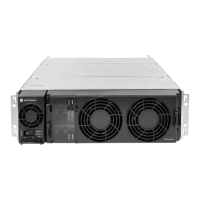Troubleshooting 3-23
3.3.4.2.4 Troubleshooting the Output Board
1. Inspect the PCB micro-strip traces for signs thermal failure (severe discoloration,
charred PCB, etc). If damage is found, replace the Output Board kit, and retest and
calibrate the PA.
2. Check for presence and condition of L8000, L8001, L8002, and L8003 of LPF for UHF
and VHF. If severe VSWR is presented to PA and SW does not react (i.e. when using
Tuner Application), these components could reflow from the PCB or could melt the air
wound coil finish resulting in shorted windings. If the coil has reflowed from the PCB or
shows signs of thermal stress but no signs of damage are visible to the PCB, replace the
air wound coil and retest PA to ensure the issue has been corrected. Recalibration may
be required if power set or detection accuracy performance is not restored.
3. Check for presence and condition of L8004. If a severe surge even occurs, this
component could become damaged. If the coil has reflowed from the PCB but no signs
of damage are visible, replace the air wound coil and retest PA to ensure the issue has
been corrected. Recalibration may be required if power set or detection accuracy
performance is not restored.
4. Key the PA to rated power, and measure the voltage at M8003. It should be
approximately 5 V at rated power.
3.3.4.2.5 Troubleshooting the Isolator Load
If a severe reflected power condition or surge event occurred, it is possible that damage to the
isolation load may occur. Although unlikely, this should be verified whenever it is suspected that this
type of event occurred.
1. Inspect the load for signs of severe thermal stress (i.e. discoloration or solder joint
fatigue).
2. Verify load impedance is ~50 Ω. When verifying the isolation load impedance, it is
required to disconnect the conductor from the Circulator tab or it will not be possible to
accurately measure the load impedance.
3.3.4.2.6 Troubleshooting the Circulator
When low or no output power is observed, but current draw indicates that the final amplifiers are
working properly and are providing notable RF output power to the Circulator, it is possible that the
Circulator has failed. Although this is unlikely and it is more likely to be an issue on another board, it
should be verified if no other reason is found for the low or no output power condition.
1. Inspect load for signs of arcing at the I/Os of the Circulator. If found, replace the
Circulator and retest the PA to verify if this corrected the issue.
2. Perform DC continuity testing between the I/Os of the Circulator. For UHF, the result
should be high impedance to ground and near 0 Ω between any of the ports. If an
internal short is discovered, replace the Circulator and retest the PA to ensure it has
corrected the issue. Note that disconnection of the isolator leads from the interfacing
circuit boards and isolation load may be required to properly verify the continuity and
impedance.

